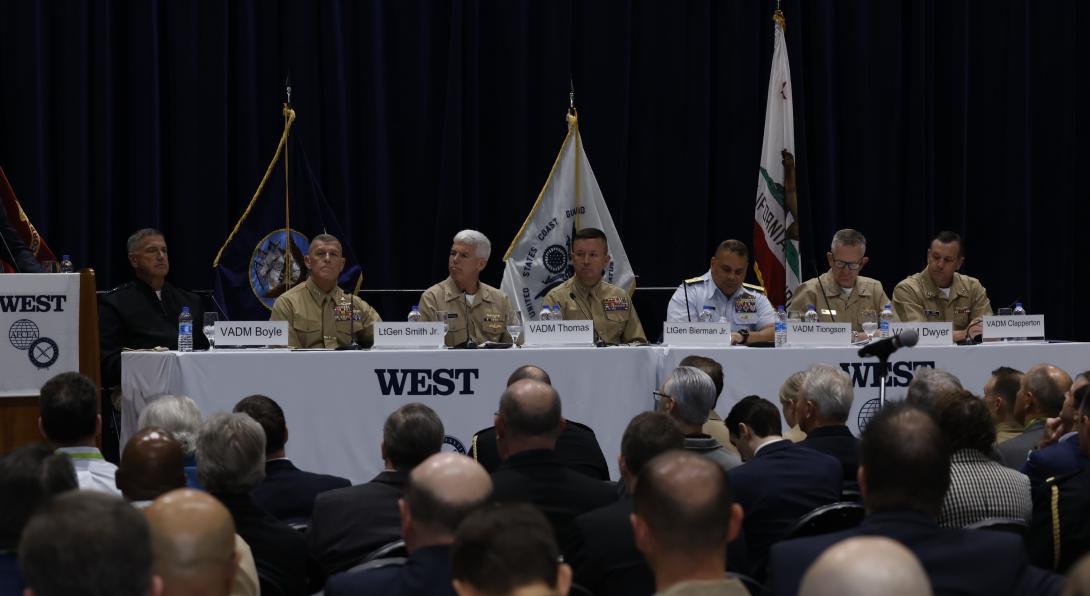A Global China Demands U.S. Military Global Presence
China’s navy creeps towards the Americas as it confronts its neighbors. But the People’s Republic has a global presence that challenges most democracies, especially in polar regions.
“In 2018 China made verbally known to the world its ambitions in the Arctic, publishing their own white paper,” said Vice Adm. Daniel Dwyer, USN, commander U.S. Navy Second Fleet, during a panel on China as the "pacing threat" at the WEST 2023 conference in San Diego.
The panel discussed how the sea lane to the north of Eurasia provides an alternative to reach the Atlantic, avoiding the Suez Canal. The northern route reduces transit times by one half, down to 20 days, and means that choke points, like Malaysia’s Malacca Straight, can be avoided.
Russia is the country with the longest coastline in the Arctic, and Moscow has decades of experience in the icy passage, closed to general shipping during the winter.
After a meeting between both countries’ leaders in 2022, diplomatic overtures placed the China-Russia relationship in new heights, “and without a doubt, part of that discussion was the support of China’s ambitions in the Arctic,” Adm. Dwyer said.
“The weaponization of the North Sea route, establishing new requirements for transit for military vessels; and the expansion of the world’s largest icebreaker fleet, which currently numbers nearly 50, and over a dozen of those are nuclear powered, shows Russia has Arctic capability,” Adm. Dwyer said.
The admiral explained how both countries sought to expand hydrocarbons infrastructure to transport Russian gas to the east, and open the supply line.
“Presence matters, we have to be present in the Arctic and we have to develop our own capabilities,” Adm. Dwyer explained, criticizing the U.S. for having only two ice breakers that must cover both poles.
While capabilities are limited, there is a production pipeline for the Coast Guard.
“We do have an icebreaking project that’s going on to provide six new icebreakers, three of which will be heavy icebreakers,” said Vice Adm. Andrew Tiongson, USCG, Pacific Area commander, Coast Guard and Defense Force West. The bigger vessels can sail through thicker ice levels in both polar regions and serve “as a way to show our flag in both the Arctic and the Antarctic,” Adm. Tiongson told the audience.
Still, allies can provide a counterweight, as “with the accession of Sweden and Finland to NATO, seven of the Arctic nations will be NATO nations,” Adm. Dwyer said.
Meanwhile, China also increased its presence in the Antarctic.
In terms of a potential armed confrontation to defend Taiwan, the limited amount of assets in the island means that to participate in the conflict, forces would need to be mobilized to cross vast areas of sea in proximity to the coast of China, offering numerous opportunities for targeting U.S. forces in transit.
One of the panelists revealed how a successful transit could be completed safely, “using the space and cyber effects that might be available to build a sanctuary where we can operate,” said Vice Adm. Michael Boyle, USN, commander of the U.S. Third Fleet.

Presence matters, we have to be present in the Arctic and we have to develop our own capabilities.
Another issue centers around the politics that complicates military pragmatism in a potential defense of the democratic island. The U.S. is unable to place significant resources there, as it would be a violation of the principles that guide the status quo in place for decades.
“One of the things that my logistics planners have reminded me of, in a sustained fight 20% of the logistics throughput is water,” said Lt. Gen. James Bierman, USCM, commanding general, III Marine Expeditionary Force and commander, Marine Forces Japan.
Gen. Bierman explained that water, fuel, food and medical supplies could be locally sourced, simplifying the logistics for forces operating in that area.
Vice Adm. Craig Clapperton, USN, commander of U.S. Fleet Cyber Command and U.S. Tenth Fleet, and Vice Adm. Karl Thomas, USN, commander of the U.S. Seventh Fleet, shared that with effective intelligence sharing the U.S. could provide significant assistance to Taiwan when defending itself, as well as cooperating in training and readiness of the island’s military.
Lt. Gen. George Smith, USCM, commanding general of I Marine Expeditionary Force, also spoke on Tuesday at the panel “With China as the Pacing Threat, What Are the Key Opportunities and Challenges? A Fleet & Fleet Marine Force Operational Perspective.”
Adm. Scott Swift, USN (Ret.), former commander, U.S. Pacific Fleet, moderated the event.




Comments